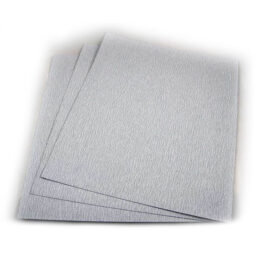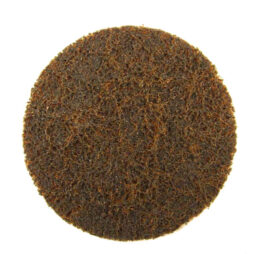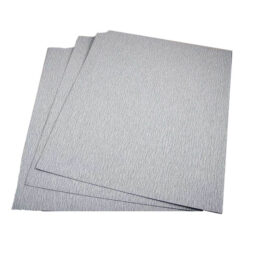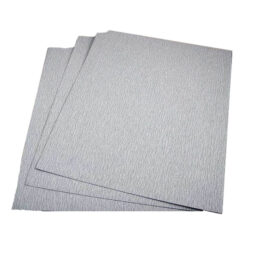Description
What is this Metal & Plastic Polishing Kit used for: The GP kit contains two polishing steps. Removes very light marks/scratches as a metal polishing kit and takes you to a bright finish.
One mop for each compound keeps the polishing simple and gets results.
If the condition of the metal is not too bad then it is an ideal kit for getting the shine back on the metal.
What metals can I use this kit for:
- Fix a buffing pad onto a power buffer. …
- Select a non-waxy stainless steel polish. …
- Apply the polish stick onto the buffing pad. …
- Place the buffer at the top corner of the surface. …
- Switch the buffer on. …
- Move the buffer or work in a circular motion. …
- Switch the buffer off and pick up a rag. …
Finished.Alloy, Aluminium, steel, stainless steel, copper, brass, titanium, iron and zinc
What does the kit contain:
1 x 4″x1/2″ White Mop (100mm x 13mm)
1 x 4″x1/2″ G Mop (100mm x 13mm)
1 x 100 gram Bar Brown Compound
1 x 100 gram Bar Blue Compound
1 x Standard Mop Taper
1 x Instruction
Polishing Steel, Stainless Steel & Iron.
If the metal is in a poor condition then abrasives will be needed. Thats where experience of polishing comes in, looking at then metal and knowing what process you need to start at.
You will need to get the surface to 240/400 grit before you start polishing at process 1.
If the condition of metal is not too bad or you have the surface to 600 grit + then you could start at process 2.
Process 1 (Burnishing) blue compound with a sisal polishing mop
Process 2 (Prepolishing) blue compound with a white close stitched polishing mop
Process 3 (Polishing) Blue Compound or Rose Compound with a Loose G quality
Process 4 (Finishing) for super finishing with a Loose quality mop
Polishing Aluminium.
Not as hard as the above metals, steel etc. When polishing aluminium if you are getting small holes that appear when you are polishing, stop. These can not polished out they are due to the casting and if you keep polishing you will get more holes appear. Best just buff up if this happens for damage limitation.
If the metal is in a poor condition then abrasives will be needed. Thats where experience of polishing comes in, looking at then metal and knowing what process you need to start at.
You will need to get the surface to 240/400 grit before you start polishing at process 1.
If the condition of metal is not too bad or you have the surface to 600 grit + then you could start at process 2.
Some people prefer to use the green compound on Process 1 with a sisal rather than the grey.
There are a couple of option on finishing, P126 Rose is a superb finisher but for that extra special job P175 can be used.
For thin sheet Aluminium we have a new fine finishing compound available 480F, this is a light green compound thats is more greasy than the normal finishing compounds which keeps the surface cooler.
Process 1 (Burnishing) blue compound with a sisal polishing mop
Process 2 (Prepolishing) blue compound with a white close stitched polishing mop
Process 3 (Polishing) Blue Compound or Rose Compound with a Loose G quality
Process 4 (Finishing) for super finishing with a Loose quality mop
Polishing Brass, Copper & Zinc.
Would say softer than the above metals but some grades of brass can be very hard. For example towel rails, in this case use the same process as steel above.
If the metal is in a poor condition then abrasives will be needed. Thats where experience of polishing comes in, looking at then metal and knowing what process you need to start at.
You will need to get the surface to 240/400 grit before you start polishing at process 1.
Some people might want to use a brown Tripoli instead of the green.
For finishing both compounds are very good but for the extra special job use the P175. But P164 for general finishing, 480W works well as it is a compound designed for Brass and Copper only.
Process 1 (Burnishing) blue compound with a sisal polishing mop
Process 2 (Prepolishing) blue compound with a white close stitched polishing mop
Process 3 (Polishing) Blue Compound or Rose Compound with a Loose G quality
Polishing Gold & Silver.
Common two process used by the jewellers for years. There are some options on process 2, some people prefer to use a WDR or R grade mop.
Rouge has always commonly been used but compounds like the Ulto 15 and P175 are a decent alternative. If you are after a clear mirror finish then P175 if worth looking at.
Process 1 (Burnishing) blue compound with a sisal polishing mop
Process 2 (Prepolishing) blue compound with a white close stitched polishing mop
Platinum
Precious expensive metal. Harder than gold or silver.
Process 1 (Polishing) White compound with a Loose B or white stitch mop
Process 1 (Finishing) Yellow compound with a Loose G or WDR mop
Additional information
| Weight | 0.5 kg |
|---|







